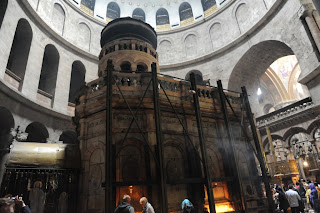The
Church of the Holy Sepulchre is built on the site where Jesus was supposedly
crucified & buried.
At
that time, Calvary (also known as Golgotha), existed outside the walls of
Jerusalem.
The
site might have looked something like this at the time:
Calvary
then became enclosed within the city walls around 43AD.
After
the Jewish revolt of 135AD (yes...there was another one after 70AD), Emperor
Hadrian renamed Jerusalem to Aelia Capitolina & had a temple dedicated to Venus
built on the site.
In
the 4th Century, Emperor Constantine converted to Christianity.
After his sister, Helena visiting the site, Constantine instructed the first church
be built.
The
church you see today is from around the mid-1800s.
Here
is a floor plan of the church:
Here
is the layout of the site at the time of Jesus, superimposed with the current layout
of the church:
The church
is administered by six different Christian faiths: Latin Catholics, Greek
Orthodox, Armenian Orthodox, Syrians, Copts & Ethiopians who each control
different parts of the church.
Who
controls what areas is governed by the “Status Quo” document – the document
also covers other Christian sites in the region. Here’s a link to the document that
I found: http://www.usahm.info/Dokumente/STATUSQUO.htm
As
you can imagine with such a united nations of faiths, difficulties can arise
and conflicts abound (more about that later).
To
really mix it up, the entrance door and the keys for
the Church of the Holy Sepulchre are under the control of two Muslim families: Nuseibeh
and Joudeh. A male member from the Joudeh family opens the church in the
morning and a male member from the Nuseibeh family closes the church at night.
Here are some photos I found on the Internet:
As an
ex-catholic, I can’t say that I felt any sense of spirituality here. To me, it
was just another church with alot of people.
I
feel much more spiritual in Ireland, sitting in the middle of a faery ring.
Here
are my photos from the visit:
 |
| The Stone of Anointing - where the body of Jesus was prepared for burial |
 |
| The Edicule - where the Tomb of Jesus is contained |
 |
| Crosses carved into the rock by pilgrims |
 |
| Looking at the Stone of Anointing from Golgotha (Calvary) |
I
mentioned earlier that when you six faiths vying for control of the church,
things can get a bit crazy.
So....we
come to the “Immovable Ladder”. Here’s a photo I took of it from the outside
courtyard:
It
has been in this spot (more or less) since the 18th Century. Its “immovability”
relates to a conflict between the Greeks and the Armenians tied in to the fact
that no cleric of the six Christian orders may move,
rearrange, or alter any property without the consent of all six orders.
The
real reason has been lost with the passing of time, but here’s one theory I
found on the net:
"The problem stems from
the fact that the two windows above belong to the Armenians and they have the
right to clean and repair them, and the cornice on which the ladder rests
belongs to the Greek Orthodox. At some point (last century) the Armenians put
out the ladder for the purpose of doing work on the windows, [and] the Greeks
protested that the ladder was resting on their portion. The Armenians refused
to remove the ladder - hence the frozen reality."


















No comments:
Post a Comment